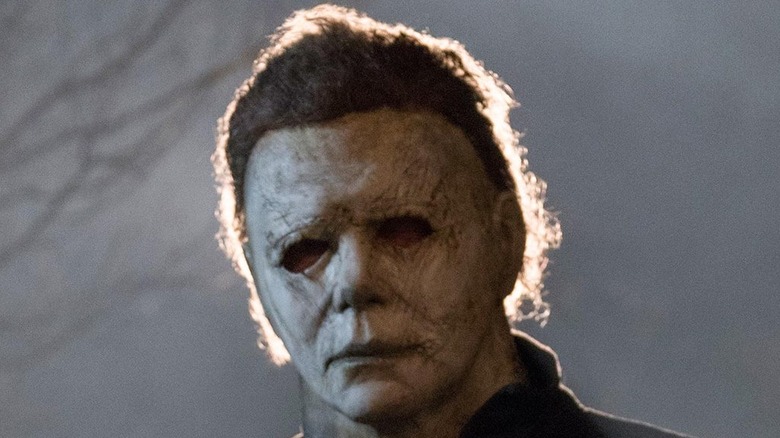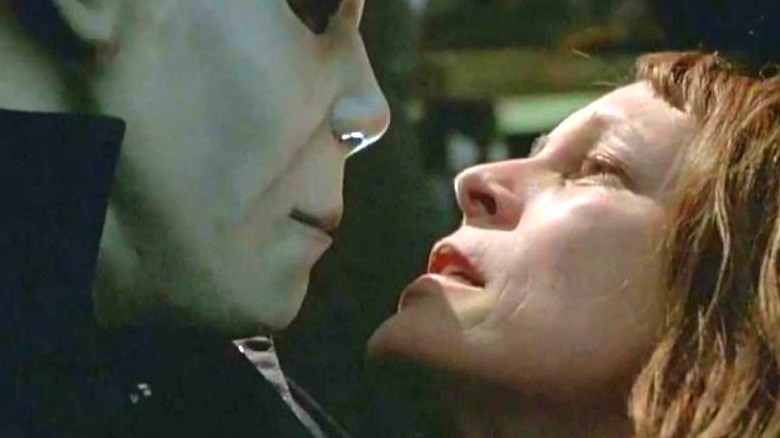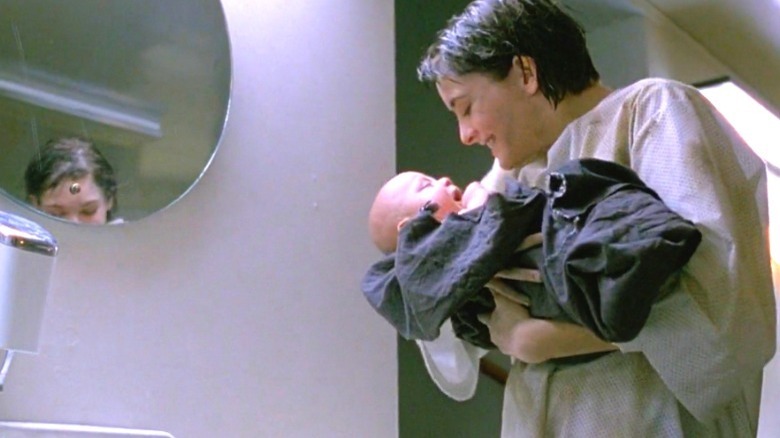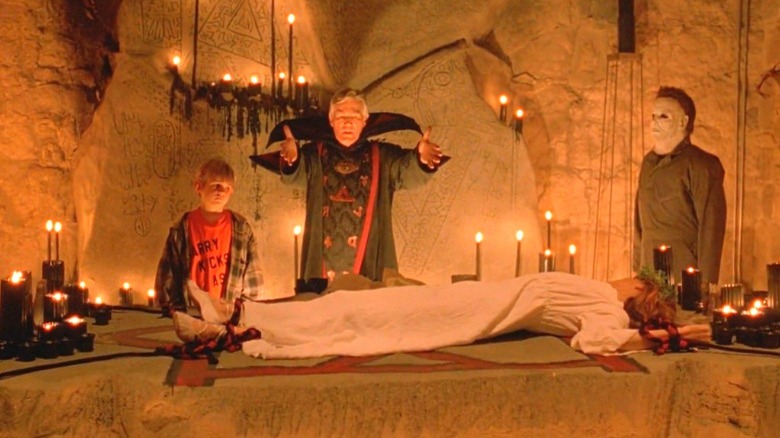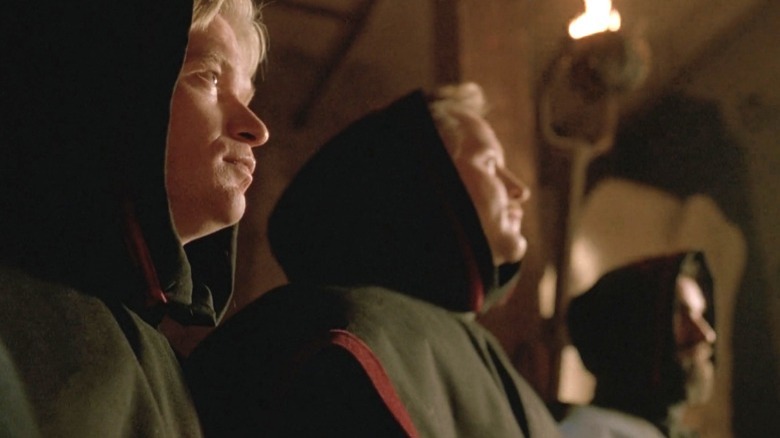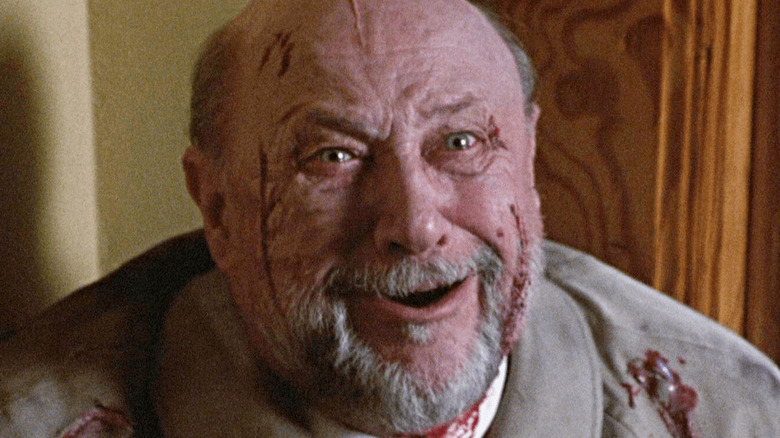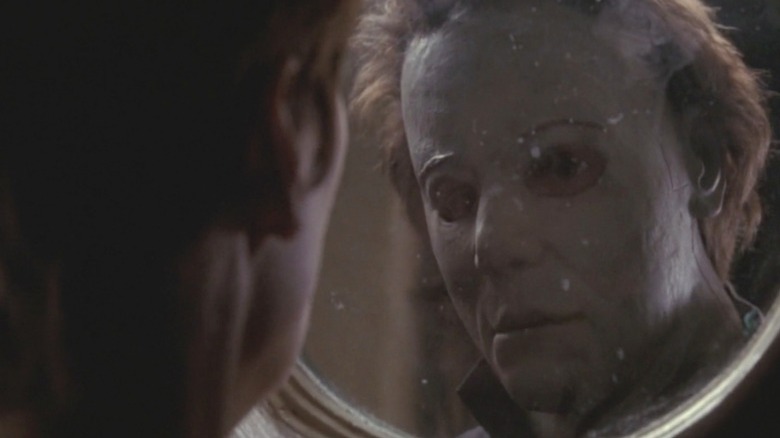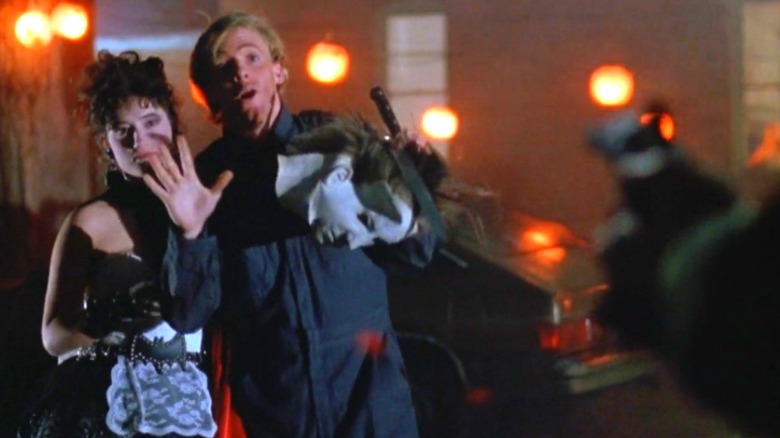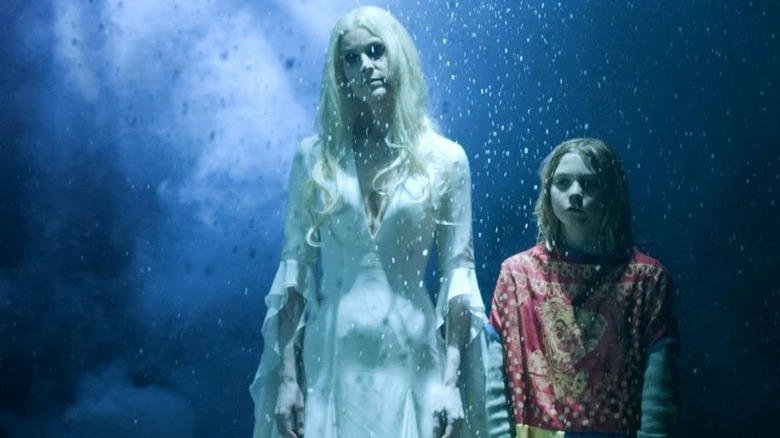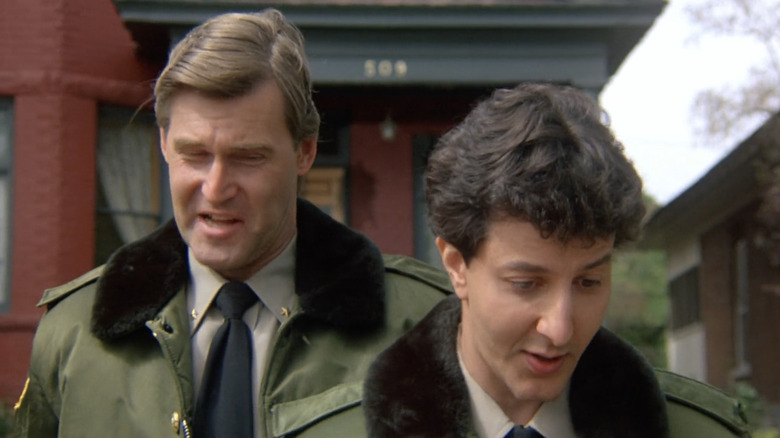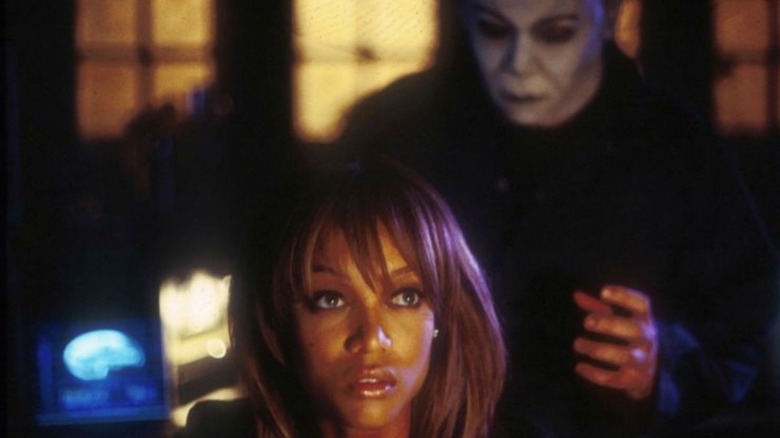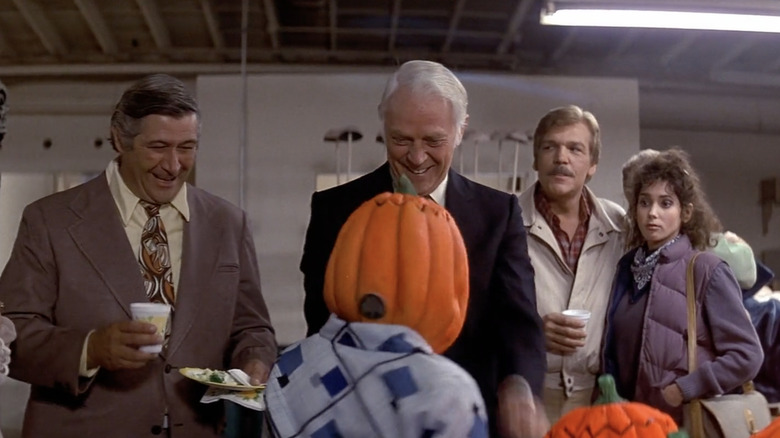Questionable Things We Ignore In The Halloween Franchise
In 1978, everyone's favorite final girl Laurie Strode, played by Jamie Lee Curtis, screamed her way into audiences' hearts with the release of John Carpenter's "Halloween." Making over $47 million on a budget of $325,000, according to Box Office Mojo, the film was an instant hit that spawned a fright-filled following that yearned for more Michael Myers-esque thrills. Three years after the original, a sequel picked up the plot mere seconds after the original film's story ended. From there, a franchise was born as Michael Myers ascended into the pantheon of the icons of modern horror alongside figures like Jason Voorhees, Freddie Kreuger and the Xenomorph.
As evidenced by the ticket sales of the confusingly titled "Halloween" in 2018, which made over $255 million 40 years later, film audiences cannot get enough of Michael Myers and his standoff with Laurie Strode. While excitement for the franchise may be at an all-time high, a lot has happened in those 40 years, and not all things have been well received by even the most enthusiastic of fans. While it would be nice to have a franchise stuffed to the gills with frantic thrills and nail-biting action, that isn't the case with all "Halloween" movies. In fact, some things are so questionable we actively try to ignore them. However, if Laurie Strode has taught us anything, it's that we must face our fears head-on.
It has a bonkers timeline full of retcons
With over 10 entries in the "Halloween" canon, it can be challenging to remember what has happened before any given movie, and that's not entirely the viewer's fault. "Halloween" debuted in 1978, and by the time the 20-year anniversary film, "Halloween H20: 20 Years Later," released in 1998, there were six movies filled with different characters. Instead of trying to tie together the plots of all the films, "Halloween H20" retconned everything outside of the original movie and its sequel. In this version of events, films four through six never occurred, meaning Laurie Strode never had a kidnapped, impregnated daughter who Michael Myers murdered. Instead, Laurie faked her death, assumed a new identity and had a son.
Nine years later, Rob Zombie tried his hand at making a "Halloween" movie, but he started over. His sequel made for another, separate timeline mainly unrelated to the two existing branching timelines. When the franchise returned in 2018 for a soft reboot, it erased everything except the original "Halloween" as if it was a direct sequel 40 years in the making. It slyly addressed this in the 2018 film when one character brings up plot points from "Halloween 2" and is bluntly told those were only rumors.
Though the branching arcs and characters may intimidate new viewers, at the end of the day and excluding "Season of the Witch," the series is still relatively straightforward. The Strode family is haunted by the trauma of the events of the original "Halloween," and a relentless serial killer terrorizes the town of Haddonfield.
Michael is the father of his niece's child
"Halloween: The Curse of Michael Myers" starts with Michael hunting down Laurie Strode's 15-year-old daughter, Jamie (J.C. Bandy), and her newborn. Knowing Michael is after her, Jamie calls into a radio show to ask psychiatrist Dr. Sam Loomis (Donald Pleasance) for help, then immediately hides her baby. Soon after, Michael finds and kills Jamie, but her baby is found by a grown-up Tommy Doyle (Paul Rudd) — the boy Laurie was babysitting in the first film. Theorizing that Michael is intentionally targeting members of his own family, Tommy endeavors to hide the infant from the killer.
Being the nigh-unstoppable killing machine he is, Michael eventually catches up with the baby. In a last-ditch effort to convince Michael not to kill an infant who somehow survived its first days outside the womb without proper care, a character reveals Michael could be the father of the baby in a producer's cut of the movie. So what does this mean? Michael apparently sired a son with his sister's 15-year-old daughter. At least, her character should be 15 since she was kidnapped at 9 and imprisoned for six years, but it's not clear how old the character is meant to be since the actress was 20 when the film released. The implication of incest is thankfully omitted in the theatrical cut, which without a doubt, makes it the stronger version. Given the uncomfortable nature of this reveal, it's probably better to stick to the wider release's story and pretend an incestuous relationship never happened.
There's a cult-ish turn in The Curse of Michael Myers
The hectic opening of "Halloween: The Curse of Michael Myers" should tip viewers off right away this will not be an average entry in the franchise. A woman giving birth is surrounded by doctors wheeling her gurney through an industrial area only to continue into a stone-carved cavern lit with torches. Once the newborn is delivered, it's given to a mysterious figure before the baby's mother is given a chance to hold him. The infant is then placed on a stone altar and has a Thorn symbol drawn in red on its abdomen. Surrounding the newborn are three figures clad in black robes, unlike anything that has been seen in a "Halloween" film until this point in the franchise.
These robed figures are the movie's primary villains. It is eventually revealed this apparent cult has found a way to control Michael using an ancient rune of darkness known as Thorn. Their claim seems to be confirmed in the producer's cut when Tommy succeeds in halting Michael's rampage by using ancient runes of light. Also in this version, the cult leader transfers his Michael-controlling powers to Dr. Loomis while simultaneously giving him a magical tattoo of the Thorn symbol. However, this is never fully explained in either release, given production difficulties. Since "The Curse of Michael Myers" has the lowest critics' score of any "Halloween" film on Rotten Tomatoes, the confusing cult activity is best left in the cavern's shadows.
The robes of Michael's acolytes are almost comical
Aside from how silly and un-"Halloween" some of the cultish elements of "The Curse of Michael Myers" may seem, a detail that sticks out is how campy the cult members look. Except for the cult's leader, who wears a black overcoat and spurs when walking around Haddonfield, every member is dressed in robes that even Party City would deem too over the top.
The robes themselves are black with red felt trim and have the Thorn symbol stitched into the hood. Cult members also wear black pants, shoes and gloves to complete their murderous fashion statement. What makes the cultish gear truly outrageous is how incredibly large and stiff the members look wearing them, almost as if each one was laid flat and sprayed with too much starch while being ironed. Considering the serious tone many of the "Halloween" movies cultivate, these cheap outfits are more befitting a group of friends getting together to go LARPing than a small-town cult harnessing the primeval power of evil manifested in the body of a man in a Halloween mask. However, given the bizarre nature of the sixth film's overall production, perhaps these costumes fit the tone perfectly.
How deranged yet vindicated Loomis always is
Though Donald Pleasence died unexpectedly in 1995, he remained a fixture in the "Halloween" franchise over a decade after his passing, with references to his character and voice clips from earlier films abounding in the 2018 soft reboot of the series. Having been assigned to Michael's case directly after the child first committed murder, Dr. Sam Loomis has had 15 years with Michael and has decided Michael is no longer a man but evil in a human shape by the time the original "Halloween" story starts. From the moment Michael escapes, Dr. Loomis is hellbent on taking Michael down by any means necessary, even if it means blowing himself up, traumatizing children, giving a bunch of locals inferred permission to paranoidly patrol the town with rifles, or holding police officers at gunpoint.
Throughout the series, the authority figures who interact with Loomis repeatedly underplay Michael's threat to their communities and dismiss the doctor. This isn't restricted to police chiefs, sheriffs or government officials; even the psychiatrist's colleagues believe he should receive mental health counseling instead of dispensing it. While he is undoubtedly obsessive, Dr. Loomis is almost always right whenever he suspects Michael is at large. The only time Dr. Loomis is repeatedly wrong is in his guesses of how to kill Michael Myers. Come to think of it, maybe traumatizing Jamie Lloyd by threatening her with death by Michael's hands may not have been the doctor's most sound decision.
Michael disappears while characters stare at him
There are numerous shots throughout the "Halloween" franchise of Michael locking eyes with his victims in a menacing fashion. These are always tense moments, as they often signal the victim beginning to understand the danger they're truly in. These shots also have a sort of calm-before-the-storm vibe to them, focusing on stillness and inaction to better punctuate the frantic fleeing and stabbing that is usually about to commence.
However, one odd choice throughout the franchise is the tendency to follow a specific sequence of shots in these interactions. First, the camera shows Michael staring at his victim. What follows is a shot-reverse shot of the victim looking at Michael. Then, the camera cuts back to where the character is staring, only to show an empty, Michael-less space. Sometimes, this gives Michael the appearance of teleporting, as the character's gaze doesn't tend to follow him to where he moved. While this is obviously an attempt by the filmmakers to make Michael Myers more threatening, it actually raises more questions than answers. In a matter of seconds, Michael seemingly warps across the room or safely off-screen, breaking some of the tension built previously in the scene. Though it may admittedly be awkward to watch Michael walk from point A to point B in every instance, some diverse editing may help to make these instances more believable.
Haddonfield has lax Halloween costume rules
By the time "Halloween: The Curse of Michael Myers" happens, 17 years have passed since Michael escaped from the institution in which he'd previously been imprisoned for 15 years for murdering his older sister. Upon obtaining his freedom, he returned to Haddonfield to attack high school babysitter Laurie Strode, who happened to be his younger sister. This means Michael's murders have haunted the town for years. However, "The Curse of Michael Myers" is the first time the holiday seems to have been banned by the local government ahead of time and not unceremoniously canceled on the day-of via police-enforced curfew.
It seems odd Haddonfield would go so far as to ban the public celebration of a holiday entirely, do nothing else, and then do so three decades since Michael's first murder. Aside from the two Halloweens 15 years apart where Michael murdered one sister then attempted to murder his other one, there have been several incidents that probably should have been on local officials' radars. In "Halloween 4: The Return of Michael Myers," one of the police's problems is that so many kids have dressed up as their town's favorite serial killer. A similar problem presents itself in the following film, "The Revenge of Michael Myers," where Tina's friend dresses as Michael Myers, allowing people to mistake Michael for a teenager pulling a joke on his friends. Instead of banning the whole holiday, it seems like banning the costume may have been a better choice.
Rob Zombie's Halloween 2 is a surreal trip
Rob Zombie's "Halloween" films are contentious among fans of the franchise. While some admire the backstory allotted to Michael's character, others find the characterization diminishes his impact and is unnecessary. However, what most fans agree on is that Rob Zombie's "Halloween 2" is one of the most bizarre entries in the series, feeling much more like a stylistic Rob Zombie film than a "Halloween" film.
To some extent, Zombie's "Halloween 2" follows similar story beats to the original "Halloween 2." Laurie Strode and Michael Myers are confirmed to be siblings. Unlike the original film, Zombie's "Halloween 2" focuses more on the psychological aspect of the characters and delves into surrealist territory. The film features several hallucinations that link the siblings' psyches. Notably, Laurie begins to envision herself carrying out Michael's past murders.
Eventually, Laurie is remanded to the care of an institution similar to the one that held her brother for 15 years prior. Here we see the most outlandish imagery in the entirety of the "Halloween" franchise, involving a hallucination of a white horse that feels more akin to a fantasy film than should be in "Halloween 2." Overall, Zombie's "Halloween 2" is one of the oddest films in the "Halloween" franchise, and the abstract nature of the movie is often forgotten or ignored when discussing some of the latter, more disliked, films in the series.
Halloween 5 has off-the-wall sound effects
One of the most effective ways to make a horror film scary is through clever sound design. Most people familiar with jump scares know that music and sound effects are frequently used to elicit a reaction out of audience members — and not always a well-liked reaction. According to Rebekah McKendry, who holds a Ph.D. in horror and teaches at USC, a jump scare can be terrifying if it's well constructed. And while jump scares get a bad rap, deservedly so in many cases, they aren't the end-all-be-all of sound design that enhances the fear factor in film and television.
Beyond jump scares and the use of a film's score, sound effects that aren't made to scare in and of themselves can be hugely influential at ratcheting up the tension of any given scene. For instance, the metallic "shing" of a knife as it's drawn helps reinforce its sharpness in the mind of audience members, and a loud "thwack" that rings out when such a blade is plunged into its target can make the impact seem much harder than the visual alone.
With so much potential to enhance the immersion and mood of a scene, the misuse of sound effects is often glaring and immersion-breaking. While the "Halloween" films generally use sound effects well, there are a few poignant instances where they feel distinctly out of place. The best example of this comes in "Halloween 5: The Revenge of Michael Myers." During a comedic scene between two police officers, a series of clown sound effects ("boing" and "honk") are played during their banter without any explanation.
Livestreams in 2002 wouldn't have worked that way
"Halloween: Resurrection" features a group of teens wandering around the abandoned Myers house on Halloween night as part of an internet livestream. Little do the participants or the show's producers know that Michael Myers has made his way back to his childhood home, ready to kill anyone he gets his hands on. The show functions by having all the cameras accessible to audiences to watch at any time, with the winner being the contestant the most viewers chose to watch. When it becomes clear to viewers that contestants really are being murdered and aren't playing pranks on other participants for views, the mood inside and outside the house becomes less lighthearted. Luckily, one contestant has a friend watching who texts her Michael's location as he checks other cameras. This ends up saving her life a couple of times and even earns the guy a shoutout once reporters show up to get a statement from the survivor still wrapped in a shock blanket.
While this works well for the characters in the film, it seems a bit suspect that a livestream with upwards of a dozen cameras all streaming live would have no lag operating within a small Illinois town's 2002 internet infrastructure. Aside from having instantaneous uploading, there also appears to be no issue on the viewing end with buffering or loading as up-to-the-second info on Michael is sent via text. Even if tried today, there would likely be at least a several-second-long delay for viewers at home, and certainly, a few more seconds to wait for a text message to send.
Halloween 3 was meant to launch an anthology series
"Halloween 3: Season of the Witch" is the obvious black sheep of the franchise. With no mention of Michael Myers, Laurie Strode, or even the town of Haddonfield, it's questionable why "Season of the Witch" is even considered part of the "Halloween" franchise at all. That may be because it was never meant to continue the "Halloween" franchise as it's known today. According to Collider, John Carpenter was prompted to write a sequel after the success of the original "Halloween" despite not having a story left to tell. Even so, "Halloween 2" was a box office success, which naturally meant Carpenter and his co-writer Debra Hill were again asked to make another sequel. Carpenter agreed, but on the condition there would be no Michael Myers.
"Season of the Witch" follows a doctor who witnesses a murder-suicide inside his hospital. Along with the daughter of the murdered patient, he attempts to unravel a messy conspiracy surrounding Silver Shamrock, a company that makes Halloween masks. Carpenter's idea was that "Halloween 3" was meant to spark an anthology series. As the film's director said at the time, "By using this title, it is our intention to create an anthology out of the series, sort of along the lines of 'Night Gallery,' or 'The Twilight Zone,' only on a much larger scale, of course." Unfortunately, due to poor critical reviews, audience backlash, and poor ticket sales, the series never moved forward. As a result, "Halloween III" is the most misunderstood film in the franchise and likely the most skipped upon series rewatches.
